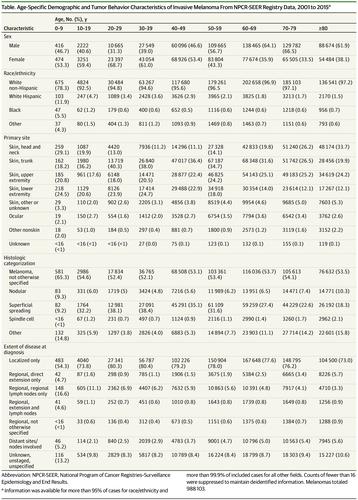当前位置:
X-MOL 学术
›
JAMA Dermatol.
›
论文详情
Our official English website, www.x-mol.net, welcomes your feedback! (Note: you will need to create a separate account there.)
Age-Specific Incidence of Melanoma in the United States.
JAMA Dermatology ( IF 10.9 ) Pub Date : 2019-11-13 , DOI: 10.1001/jamadermatol.2019.3353 Kelly G Paulson 1, 2, 3 , Deepti Gupta 4, 5, 6 , Teresa S Kim 3, 7 , Joshua R Veatch 1, 2, 3 , David R Byrd 3, 7 , Shailender Bhatia 1, 2, 3 , Katherine Wojcik 1 , Aude G Chapuis 1, 2, 3 , John A Thompson 1, 2, 3 , Margaret M Madeleine 8, 9 , Jennifer M Gardner 3, 5
JAMA Dermatology ( IF 10.9 ) Pub Date : 2019-11-13 , DOI: 10.1001/jamadermatol.2019.3353 Kelly G Paulson 1, 2, 3 , Deepti Gupta 4, 5, 6 , Teresa S Kim 3, 7 , Joshua R Veatch 1, 2, 3 , David R Byrd 3, 7 , Shailender Bhatia 1, 2, 3 , Katherine Wojcik 1 , Aude G Chapuis 1, 2, 3 , John A Thompson 1, 2, 3 , Margaret M Madeleine 8, 9 , Jennifer M Gardner 3, 5
Affiliation

|
Importance
Melanoma is epidemiologically linked to UV exposure, particularly childhood sunburn. Public health campaigns are increasing sun-protective behavior in the United States, but the effect on melanoma incidence is unknown.
Objective
To examine the incidence of melanoma in the United States and whether any age-specific differences are present.
Design, Setting, and Participants
Observational, population-based registry data were extracted on July 3, 2018, from the combined National Program of Cancer Registries-Surveillance Epidemiology and End Results United States Cancer Statistics database for 2001-2015. Deidentified data for 988 103 cases of invasive melanoma, with International Classification of Diseases for Oncology histologic categorization codes 8720 to 8790, were used for analysis. Data analysis was performed from July 1, 2018, to March 1, 2019.
Main Outcomes and Measures
The annual rates of melanoma in pediatric, adolescent, young adult, and adult age groups were determined. Analyses were stratified by sex, and incidence rates were age-adjusted to the 2000 US standard population. Annual percentage change (APC) in incidence rate was calculated over the most recent decade for which data were available (2006-2015) using the weighted least squares method.
Results
In 2015, 83 362 cases of invasive melanoma were reported in the United States, including 67 in children younger than 10 years, 251 in adolescents (10-19 years), and 1973 in young adults (20-29 years). Between 2006 and 2015, the overall incidence rate increased from 200.1 to 229.1 cases per million person-years. In adults aged 40 years or older, melanoma rates increased by an APC of 1.8% in both men (95% CI, 1.4%-2.1%) and women (95% CI, 1.4%-2.2%). In contrast, clinically and statistically significant decreases were seen in melanoma incidence for adolescents and young adults. Specifically, incidence rates decreased by an APC of -4.4% for male adolescents (95% CI, -1.7% to -7.0%), -5.4% for female adolescents (95% CI, -3.3% to -7.4%), -3.7% for male young adults (95% CI, -2.5% to -4.8%), and -3.6% for female young adults (95% CI, -2.8% to -4.5%). Data on skin pigmentation and sun protection history were unavailable; similar trends were observed with data limited to non-Hispanic whites. Young adult women appeared to have twice the risk of melanoma as young adult men.
Conclusions and Relevance
The incidence of invasive melanoma in the United States appeared to decrease in adolescents and young adults from 2006 to 2015, and this finding contrasted with increases in older populations. These incidence trends suggest that public health efforts may be favorably influencing melanoma incidence in the United States.
中文翻译:

在美国,黑素瘤的特定年龄段发病率。
重要性黑色素瘤在流行病学上与紫外线暴露(尤其是儿童晒伤)相关。在美国,公共卫生运动正在增加防晒行为,但对黑素瘤发病率的影响尚不清楚。目的研究美国黑色素瘤的发病率以及是否存在任何年龄差异。设计,设置和参与者于2018年7月3日从2001-2015年国家癌症登记-监视流行病学和最终结果美国癌症统计数据库的组合中提取了基于人群的观察性登记数据。分析的不确定性数据为988103例浸润性黑色素瘤,采用国际肿瘤分类学组织学分类代码8720至8790。从2018年7月1日开始进行数据分析,至2019年3月1日。主要结果和措施确定了小儿,青少年,成年和成年年龄组的黑色素瘤年发病率。分析按性别进行了分层,并且对发病率进行了年龄校正,以适应2000年美国标准人群。在最近十年中,使用加权最小二乘法计算了可获得数据(2006-2015年)的发病率的年度百分比变化(APC)。结果2015年,美国报告了83 362例浸润性黑色素瘤病例,其中67例小于10岁的儿童,251例青少年(10-19岁)和1973例青少年(20-29岁)。在2006年至2015年期间,总发病率从每百万人年200.1例增加到229.1例。在40岁以上的成年人中,两名男性的黑色素瘤发生率均提高了1.8%(95%CI,1。4%-2.1%)和女性(95%CI,1.4%-2.2%)。相反,青少年和年轻人的黑色素瘤发生率在临床和统计学上均显着下降。具体来说,男性青少年的发病率下降APC -4.4%(95%CI,-1.7%至-7.0%),女性青少年-54%(95%CI,-3.3%至-7.4%),-男性年轻人为3.7%(95%CI,-2.5%至-4.8%),女性年轻人为-3.6%(95%CI,-2.8%至-4.5%)。没有关于皮肤色素沉着和防晒历史的数据;对于非西班牙裔白人,数据也观察到了类似的趋势。年轻成年女性似乎患黑色素瘤的风险是年轻成年男性的两倍。结论与相关性从2006年至2015年,美国青少年和年轻人中浸润性黑色素瘤的发病率似乎有所下降,这一发现与老年人口的增加形成了鲜明对比。这些发病率趋势表明,公共卫生工作可能会对美国的黑色素瘤发病率产生有利的影响。
更新日期:2020-01-08
中文翻译:

在美国,黑素瘤的特定年龄段发病率。
重要性黑色素瘤在流行病学上与紫外线暴露(尤其是儿童晒伤)相关。在美国,公共卫生运动正在增加防晒行为,但对黑素瘤发病率的影响尚不清楚。目的研究美国黑色素瘤的发病率以及是否存在任何年龄差异。设计,设置和参与者于2018年7月3日从2001-2015年国家癌症登记-监视流行病学和最终结果美国癌症统计数据库的组合中提取了基于人群的观察性登记数据。分析的不确定性数据为988103例浸润性黑色素瘤,采用国际肿瘤分类学组织学分类代码8720至8790。从2018年7月1日开始进行数据分析,至2019年3月1日。主要结果和措施确定了小儿,青少年,成年和成年年龄组的黑色素瘤年发病率。分析按性别进行了分层,并且对发病率进行了年龄校正,以适应2000年美国标准人群。在最近十年中,使用加权最小二乘法计算了可获得数据(2006-2015年)的发病率的年度百分比变化(APC)。结果2015年,美国报告了83 362例浸润性黑色素瘤病例,其中67例小于10岁的儿童,251例青少年(10-19岁)和1973例青少年(20-29岁)。在2006年至2015年期间,总发病率从每百万人年200.1例增加到229.1例。在40岁以上的成年人中,两名男性的黑色素瘤发生率均提高了1.8%(95%CI,1。4%-2.1%)和女性(95%CI,1.4%-2.2%)。相反,青少年和年轻人的黑色素瘤发生率在临床和统计学上均显着下降。具体来说,男性青少年的发病率下降APC -4.4%(95%CI,-1.7%至-7.0%),女性青少年-54%(95%CI,-3.3%至-7.4%),-男性年轻人为3.7%(95%CI,-2.5%至-4.8%),女性年轻人为-3.6%(95%CI,-2.8%至-4.5%)。没有关于皮肤色素沉着和防晒历史的数据;对于非西班牙裔白人,数据也观察到了类似的趋势。年轻成年女性似乎患黑色素瘤的风险是年轻成年男性的两倍。结论与相关性从2006年至2015年,美国青少年和年轻人中浸润性黑色素瘤的发病率似乎有所下降,这一发现与老年人口的增加形成了鲜明对比。这些发病率趋势表明,公共卫生工作可能会对美国的黑色素瘤发病率产生有利的影响。

























 京公网安备 11010802027423号
京公网安备 11010802027423号